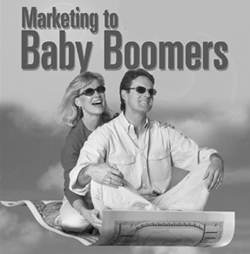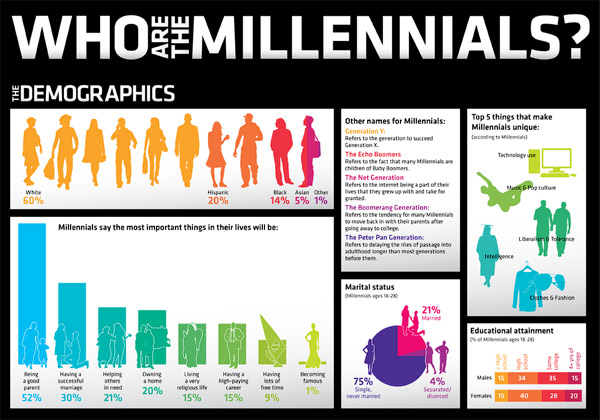Inbound Marketing: Targeting Your Market Segment

Targeting your market segment is a simple idea in inbound marketing. You wouldn’t sell long-term-care insurance to a college student or target body piercings to people living in-home care situations. You do want to sell your product or service in an appropriate way to different segments of the population, those who share experiences, values and goals. People are grouped based on influential events that happened in society around the time they were coming of age. This is different than just grouping them based on demographics, like their date of birth, income and occupation. Another way to group people is through psychographic life-stage segments, like young families, empty-nesters or careerists. But there are also other factors that are tied to particular dates as well, those based on such events as the end of World War II, the Kennedy assassination and Bart Simpson (Generation X).
Market segment targeting combines both the demographic and psychographic information to learn who to target and how. We will spend a brief amount of time talking about a few of the market segments, but you need to do much more research before you know exactly who you are targeting and the best ways to do that. For this discussion we are going to use the demographics of the largest segments around as of 2009. This information comes from Bidwell ID, LLC of Florence, MA.
The Post WWII Group
The Post WWII group members were born between 1928 and 1946 and made up 23% of the US adult population in 2009. This group had their coming-of-age events during the 1950s of the I Love Lucy Show, the Andy Griffith Show and Father Knows Best. They enjoyed long periods of social tranquility and only hints of the bomb, bomb shelters and the Cold War. The times were conservative and conformist. People valued the comfortable, familiar and security.
Baby Boomers One and Two
There are now two market segments consisting of Baby Boomers, with different outlooks based on their experiences coming of age. Baby Boomer Ones, who made up 17% of the adult US population, have dominated marketing since they first appeared. Some of the products associated with them are hula hoops, Coke, McDonalds and Clearasil. Their big life-defining moment occurred when President John F. Kennedy was assassinated, thus ending the status quo of the Post WWII market segment and thrusting many of Boomers into political activism. Individualism became key. They asked questions and expected marketing to provide more information to prove their claims. Inbound marketers see this market segment looking at many blogs before making a decision.
The second market segment of Baby Boomers makes up 26% of the population (that’s over a fourth). They were shaped by the end of the Vietnam War, Watergate and the Arab oil embargo. They experienced an economic roller coaster and high inflation. They were encouraged to go into debt to maintain their lifestyle. A major finance company ran an ad campaign telling the late boomers that everyone else has the great stuff and they aren’t any better than the consumer. You can see this in the high end car ads today.
Generation X, N-Gens and Millennials
Generation X is a market segment some marketers call “a generation of aging Bart Simpsons.” Consisting of about 22% of the population, they are classified as being alienated and resigned to the world offering them a bleak future. You can see this in the many of the current crop of futuristic movies. They are followed by the N-Gens, who are hopeful about the future (also as seen in the same movies). This is the group that came of age as the computer and internet became popular. They are sometimes included in the Millennial Group, which is sometimes segmented like the Boomers.
These are all different market segments of people with different kinds of buying habits. If you are aware of which market segment you are targeting, you won't make a big mistake in your inbound campaign because you will take into account that the people you are marketing to want more information before making up their minds, like the Baby Boomer Ones or they feel entitled to the best like Baby Boomer Twos.
Do you know which market segment you are marketing to and how to reach each differently?
For more information
- Target Market--How to find your Target Market; BroadVision Marketing.com
- Step 1: Itentify Market Segments: KnowThis.com
 Jaco Grobbelaar is the owner of BroadVision Marketing. BroadVision Marketing works with business owners to put in place inbound and outbound marketing strategies that consistently secure new clients. The BroadVision Marketing Training Center is located in Petaluma, CA and primarily serves companies in the San Francisco Bay area.
Jaco Grobbelaar is the owner of BroadVision Marketing. BroadVision Marketing works with business owners to put in place inbound and outbound marketing strategies that consistently secure new clients. The BroadVision Marketing Training Center is located in Petaluma, CA and primarily serves companies in the San Francisco Bay area.
Jaco can be reached at jaco@broadvisionmarketing.com or 707.766.9778 or connect with Jaco on Facebook - www.facebook.com/broadvisionmarketing - and LinkedIn - www.linkedin.com/in/JacoGrobbelaar.
You May Also Like
These Related Stories

Successful Marketing Strategy: Who Are You Targeting?

Inbound Marketing Strategy—Aiming for Your Target Market



No Comments Yet
Let us know what you think